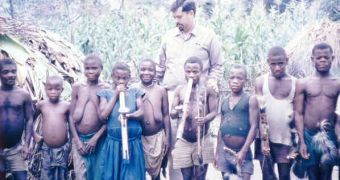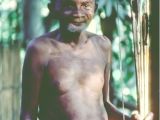Even if the old Egyptian and Greek texts mentioned the existence of very short people inside the heart of Africa, for a long time this was considered just a fiction.
"Pygmaeus" in ancient Greek means feet.
This was considered so till 1874, when a German explorer encountered the first pygmies ever seen by an European in the current Congo republic.
Despite what many could think, the pygmies are not dwarf individuals.
Amongst those of pure blood, the men have an average height of just 1.45 m (4.34 ft) and the women of 1.33 m (4 ft)!
Pygmies are confounded by many as a dwarf variant of the Black Africans. Wrong!
They have the head the same size like other humans, that's why their heads look large compared to the rest of the body. But otherwise, they are perfectly proportioned (the dwarfs are deformed).
Pygmies represent an ancient race and only the Khoi-San people (bushmen), now restricted to South Africa, are more ancient amongst current human races.
They are more related to the so-called Asian Blacks, that inhabit much of India, New Guinea, Melanesia and have a great deal of genes in many populations from South Asia and Polynesia.
Indeed, unlike typical African Blacks, pygmies have hairy bodies and faces and rather aquiline noses, not flattened and a lighter skin. In fact, pygmies were amongst the first people to have left Africa to colonize Asia, and at a moment, they inhabited much of south Asia.
Local relict populations of pygmy race are found not only in Africa, but also in many parts of southern Asia: Aeta in Philippines, Semang in Malaya, Mani in Thailand, the Andamanese tribes from the Andaman archipelago, Rampasasa from Flores island and many pygmy tribes in the mountains of New Guinea or in Vanuatu archipelago.
Pygmies survived just in the most inhospitable places, isolated from the surrounding populations, like dense tropical forests, where they can still bear their traditional life style of hunters-gatherers, like all prehistoric people did 10.000 years ago.
Two millenia ago, pygmies inhabited most of Central Africa, but when the Bantu people (typical Black Africans) migration started from Nigeria, these newly arrived tribes, practicing agriculture and with and advanced iron technology, displaced easily the primitive pygmies.
Today, pygmies speak the language of the neighboring Bantu tribes, they lost their original languages. From Gabon and Camerun till Central African Republic, there are estimated to be around 120.000 pygmies.
Pygmies use to harbor in huts made of sticks and leaves. They are low, a little more than 1 m (3 ft) height, so they must go on all fours to get inside. Inside they make a fire used for preparing the food and keeping away the wild animals.
Pygmies enjoy playing music. They use drums made of hollow tree trunks covered by a skin patch, copied from the Bantu people, and reed made panpipes. They execute very expressive and agitated dances, imitating the movements of the animals they want to hunt, as they believe this way they put a spell on the animals that would be easier to hunt.
As pygmies do not practice agriculture, their main source of food is the hunt. They are extremely resistant and have kin senses for detecting the prey in the dense forest. They use bows with arrows (poisoned with plant juices that paralyze even the elephant hearts!), spears, maces and sometimes knifes, axes and the hunting webs, made of vines.
They rarely use traps, and this is a practice taken from the neighboring Bantu tribes. They can also use crossbows, acquired from neighboring Bantu.
Like bushmen, they prefer the hunt on the run and in groups, chasing the prey till they can shoot their arrows. Pygmies hunt everything, from monkeys to the largest animals of the forest, the elephants.
When the hunt is abundant, they eat enormously, as the aliments can not be stored, and after that they can pass entire weeks with minimal food. Hunt does not provide a steady supply, that's why the women's and children's task of gathering food is crucial: they collect forest fruits, berries, fungi, roots, rodents, snakes, lizards, frogs, termites, larvae and worms.
In fact, pygmies make barter with the neighboring Black people: they offer extra hunt meat and the other people give them agricultural products, weapons and fabrics. Of course, pygmies have excellent knowledge of the forest pharmacopeia, knowing plants that cure from gut worms to snake bites and eye diseases.
Pygmies are very reticent in their relations with the neighboring people, as during the history these varied from scorn to cannibalism (the pygmies being the victims) during the ceaseless African civil wars in the areas where they live.

 14 DAY TRIAL //
14 DAY TRIAL // 
